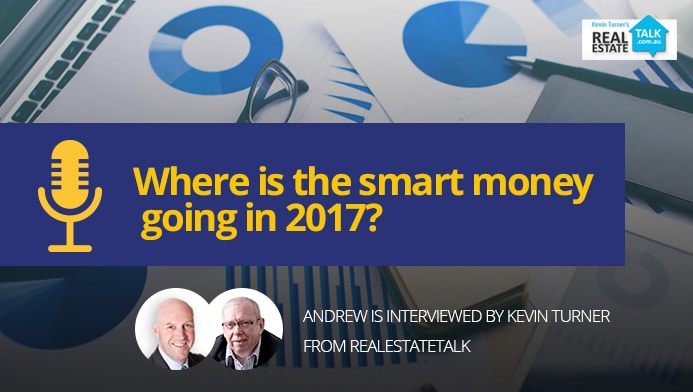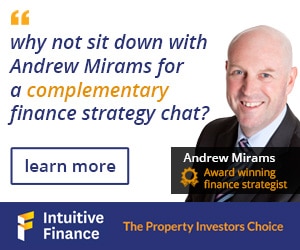Where is the smart money going in 2017? – [AUDIO INTERVIEW]

Note: There are several other experts on the show, so if you’d like to skip to Andrew’s comments – please listen from 43min onward
Kevin: Earlier in the show I was talking to Cate Bakos, and we asked her to reflect on the comments she made about this time last year about what it would be like at the end of 2016 / start of 2017, which is where we are right now. Well, here’s another one, because this time last year, I spoke to Andrew Mirams from Intuitive Finance, and Andrew joins us once again.
Andrew, Happy New Year. Good to have you on the show. Nice to talk to you, mate.
Andrew: Good day, Kevin. Happy New Year to you, too, and all the listeners.
Kevin: Okay. Let’s remind you what you said this time last year about the 2016 market.
Andrew: Melbourne and Sydney have enjoyed a couple of years of pretty good markets. Obviously, Sydney’s had a couple of great years. Melbourne still appears to be really strong, and that’s underpinned by our population growth and employment, which still seems to be quite strong in our state. It seems to be similar in Sydney, and the market seems to be still okay there.
And I think that probably Brisbane might be something where some money starts to go because people look at fundamentals and think, based on a yield, it appears to be undervalued, and there might be some opportunities in Brisbane in 2016.
Kevin: Gee, mate, I thought you were pretty spot on there. You highlighted Brisbane as the place for opportunity. Did it reach the sort of heights you thought it would, Andrew?

Andrew: It probably didn’t. But, again, if you compare that again across to Melbourne and Sydney, who have had two or three years of extraordinary growth, it probably did nothing in Melbourne and probably Sydney and Brisbane. The markets are going to start to disjoint themselves and there are going to be markets within markets with the development boom that’s happening across those three states.
Sydney is probably still a little under supplied, but I think Melbourne and Brisbane potentially in those development markets might have some grief coming into 2017 and 2018 even.
Kevin: What do you think that will do to some of the more established markets in, say, Melbourne and Brisbane? Will they continue to improve, do you think?
Andrew: I think there’s always a flight to quality. I think the apartment market has been quite strong over the last few years. Now, just the supply and demand issue, I think, is going to see that dampen quite a bit, and there’ll be a flight back to land and where people can actually develop or hold the land. As we know buildings, depreciate whereas land over the long term tends to appreciate as it becomes scarcer and harder to get ahold of.
Kevin: Yes. We mentioned earlier in the show, too, about the APRA restrictions during the year. You’re much closer to that than anyone, being in the finance world. What’s your impressions of that? What impact did it have on the market, and did you see it coming?
Andrew: Look, it’s been happening for 18 months or so now – probably two years behind the scenes – and there’s still some work to go. I don’t think we’re going to see it get any easier anytime soon.
Kevin, we’re at record low interest rates, and there has to be some caution that goes with that, I guess, because we don’t want people over-committing and things like that. So I think APRA’s still got a bit to play out. They’re now talking about commercial land and development finance and just making sure developers aren’t over-extended as well as our consumers and people not getting their fingers burnt.
I think we’ll continue to see the banks incrementally raising interest rates, even if we were to get maybe an RBA decrease. I’m not sure that we will, but there’s still some pundits saying we might get another one or two quarter-percent decreases through 2017. I’m not sure, I’m not convinced, but I think they’re at such a low rate now that we won’t see much change.
But I think you’ll see the banks, as they’ve done through 2016, continue to move and differentiate between owner-occupier lending, which started to wane at the end of 2016… It started to drop off and the investors really started to come back into the market. And I think that what that is is opportunity: those who have money and opportunity to buy are still interested in buying into the markets and taking advantage of good opportunities.
Kevin: Andrew, are you seeing any defaults, particularly in that off-the-plan marketplace? Anyone can’t settle?

Andrew: Yes, it is happening. I think 2017 and 2018 is really when a lot of these developments in the larger scale, a lot of them are going to come to market, as well.
There are a couple of things though, Kevin. Your Australian investors are still going to be able to get money subject to the APRA restrictions, but through 2016, we also saw the banks withdraw pretty much finance to non-residents, and they’ve even restricted quite significantly finance availability to our Australian ex-pats overseas, depending on where they’re earning their income and how they’re assessed.
A lot of those people are the ones who have bought these off-the-plans. Non-residents get their Foreign Investment Review Board approval, they have to buy new properties. And I suspect now with the issue of getting money into the country, particularly out of China, and then also being able to access finance over here, we might see more and more defaults happen through the course of this year and next. It’s just going to put a damper on everyone in that market because if there are fire sales of apartments in blocks, then that’s actually what the value becomes.
Kevin: You’re helping investors all around Australia. Where’s the smart money going? What are they talking to you about? Which markets?
Andrew: I still think in Melbourne and Brisbane, it’s certainly now wanting to get hold of land, so it’s getting the opportunity for that inner ring, good opportunities to develop in the future or put a second property on or not that high-density living, but now that medium-density living. Houses will be always be popular with land.
Sydney is still attractive for the apartment market because they’re still not building enough to meet the market. There’s that inner ring and then the outer west and places like that that have a real over-supply of the units out there.
Where people want to live in Sydney, Melbourne, and Brisbane is still what’s going to be popular, where possible, I think through 2017, wherever you can, if you can buy something on a tiny bit of land – whether it be a house, a townhouse, a unit, or something like that – I think is going to be the most popular selection.
 Kevin: Okay. Sum it up for me, mate. What do you think you’re going to be saying this time next year about 2017?
Kevin: Okay. Sum it up for me, mate. What do you think you’re going to be saying this time next year about 2017?
Andrew: I think we still will have had a pretty reasonable market, while we still have people in employment and low interest rates and there’s a supply and demand. There are probably less properties for sale that are highly desirable, which is creating that supply and demand issue.
So I still think our markets will be in a pretty good state by the end of 2017. Let’s hope so, anyway.
Kevin: Good on you, mate. Nice talking to you. Andrew Mirams from Intuitive Finance. We’ll talk again soon, mate.
Andrew: Thanks, Kevin. All the best.
Full transcript of the interview can be found on www.realestatetalk.com.au
- Common mortgage mistakes first‑home buyers still make in 2026 - January 5, 2026
- 2025 review: rate cuts, record prices and the rise of the first-time buyer - December 11, 2025
- Offset accounts and split loans: How they work and when they save you money - December 9, 2025
